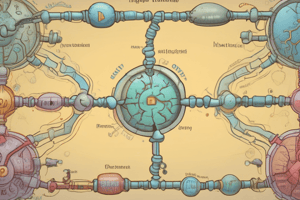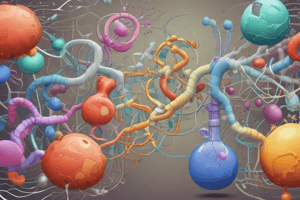Podcast
Questions and Answers
What is the major proteolytic enzyme in the stomach?
What is the major proteolytic enzyme in the stomach?
- Pepsin (correct)
- Elastase
- Chymotrypsin
- Trypsin
What activates pepsinogen in the stomach?
What activates pepsinogen in the stomach?
- Pancreatic juice
- Gastric acid (correct)
- Enteropeptidase
- Bile
Which pancreatic enzyme cleaves specifically at the C-terminal of arginine or lysine?
Which pancreatic enzyme cleaves specifically at the C-terminal of arginine or lysine?
- Elastase
- Peptidase
- Carboxypeptidase
- Trypsin (correct)
What results from a deficiency in pancreatic secretion?
What results from a deficiency in pancreatic secretion?
Which enzyme converts pancreatic trypsinogen to trypsin?
Which enzyme converts pancreatic trypsinogen to trypsin?
What is the role of aminopeptidase in protein digestion?
What is the role of aminopeptidase in protein digestion?
What type of protein digestion abnormalities can occur due to surgical removal of the pancreas?
What type of protein digestion abnormalities can occur due to surgical removal of the pancreas?
What is produced when oligopeptides are digested by enzymes on the intestinal surface?
What is produced when oligopeptides are digested by enzymes on the intestinal surface?
What primarily causes elevated serum bilirubin levels?
What primarily causes elevated serum bilirubin levels?
Which amino acid undergoes rapid oxidative deamination by glutamate dehydrogenase?
Which amino acid undergoes rapid oxidative deamination by glutamate dehydrogenase?
Which coenzyme is primarily used for oxidative deamination by glutamate dehydrogenase?
Which coenzyme is primarily used for oxidative deamination by glutamate dehydrogenase?
What role does glutamine synthetase play in ammonia transport?
What role does glutamine synthetase play in ammonia transport?
What stimulates glutamate dehydrogenase activity after protein ingestion?
What stimulates glutamate dehydrogenase activity after protein ingestion?
Which compound is produced from glutamine in the liver?
Which compound is produced from glutamine in the liver?
What process does alanine aminotransferase primarily facilitate?
What process does alanine aminotransferase primarily facilitate?
Which two factors regulate the direction of the reaction facilitated by glutamate dehydrogenase?
Which two factors regulate the direction of the reaction facilitated by glutamate dehydrogenase?
What can cause hyperammonemia?
What can cause hyperammonemia?
What is the most common hereditary cause of hyperammonemia?
What is the most common hereditary cause of hyperammonemia?
What is a major neurotoxic effect of high ammonia levels in the blood?
What is a major neurotoxic effect of high ammonia levels in the blood?
Which dietary change can help manage hyperammonemia?
Which dietary change can help manage hyperammonemia?
What is the role of phenylbutyrate in treating hyperammonemia?
What is the role of phenylbutyrate in treating hyperammonemia?
What is the primary function of aminotransferases?
What is the primary function of aminotransferases?
Which amino acids do not participate in transamination?
Which amino acids do not participate in transamination?
What coenzyme do aminotransferases require for their function?
What coenzyme do aminotransferases require for their function?
What does elevated plasma levels of aminotransferases indicate?
What does elevated plasma levels of aminotransferases indicate?
Which aminotransferase transfers amino groups from glutamate to oxaloacetate?
Which aminotransferase transfers amino groups from glutamate to oxaloacetate?
What is a key result of the reaction catalyzed by alanine aminotransferase (ALT)?
What is a key result of the reaction catalyzed by alanine aminotransferase (ALT)?
Aminotransferases are primarily located in which part of the body?
Aminotransferases are primarily located in which part of the body?
Which condition is most likely to cause high levels of AST and ALT in plasma?
Which condition is most likely to cause high levels of AST and ALT in plasma?
What is indicated by a positive nitrogen balance?
What is indicated by a positive nitrogen balance?
Which protein is more likely to have a longer half-life based on its N-terminal residue?
Which protein is more likely to have a longer half-life based on its N-terminal residue?
What primarily regulates protein turnover in cells?
What primarily regulates protein turnover in cells?
What are the two enzyme systems involved in protein degradation?
What are the two enzyme systems involved in protein degradation?
Which condition can result in negative nitrogen balance?
Which condition can result in negative nitrogen balance?
What does a steady state of the amino acid pool imply?
What does a steady state of the amino acid pool imply?
What type of proteins are generally more stable and have a longer lifespan?
What type of proteins are generally more stable and have a longer lifespan?
Which of the following can lead to increased protein catabolism?
Which of the following can lead to increased protein catabolism?
Flashcards are hidden until you start studying
Study Notes
Protein Turnover
- Steady state of amino acid pool maintained (input = output).
- Constant degradation and synthesis of proteins regulated by cellular concentration.
- Approximately 300-400g of proteins are hydrolyzed and resynthesized daily.
- Protein turnover varies by lifespan:
- Short-lived: regulatory/misfolded proteins.
- Long-lived: most tissue proteins.
- Structurally stable: collagen.
Nitrogen Balance
- Occurs when nitrogen intake equals nitrogen output.
- Positive Nitrogen Balance: more intake than output, indicating tissue growth.
- Common during growth, pregnancy, muscular training, and prolonged positive nitrogen balance.
- Negative Nitrogen Balance: output exceeds intake, leading to potential health issues.
- Consequences include starvation, malnutrition, chronic diseases, and increased catabolism.
Protein Metabolism
- Degradation via two systems:
- Energy-dependent ubiquitin-proteasome mechanism for endogenous proteins.
- Non-energy-dependent lysosomes for extracellular proteins.
- Proteins with specific N-terminal residues influence their half-life.
- Serine at N-terminal: long half-life (>20h).
- Aspartate at N-terminal: short half-life (3min).
- PEST-rich sequences result in rapid degradation.
Digestion of Proteins
- Proteins are antigenic and lose this property upon digestion.
- In stomach:
- Gastric acid denatures proteins.
- Pepsin becomes active from pepsinogen through HCl, catalyzing protein cleavage.
- In small intestine:
- Pancreatic proteases cleave polypeptides into smaller units.
- Enteropeptidase activates trypsin, which catalyzes further proteolytic activity.
Abnormalities in Protein Digestion
- Deficiencies in pancreatic secretion lead to incomplete protein and fat digestion.
- Resulting conditions include steatorrhea (abnormal lipid appearance) and undigested protein in feces.
- Aminopeptidases in the intestine cleave N-terminal residues, producing free amino acids and smaller peptides.
Transamination
- Aminotransferases catalyze transfer of amino groups to carbon skeletons, predominantly in liver, kidney, intestine, and muscle.
- All amino acids except lysine and threonine participate in transamination.
- Lysine and threonine undergo deamination instead.
Aminotransferases
- Each aminotransferase has specific amino group donors.
- Examples:
- Alanine aminotransferase (ALT) transfers alanine's amino group to α-ketoglutarate, forming pyruvate and glutamate.
- Aspartate aminotransferase (AST) transfers from glutamate to oxaloacetate, forming aspartate.
Mechanism of Action of Aminotransferases
- Require pyridoxal phosphate as a coenzyme to transfer amino groups.
- Converts amino acid to aldehyde form, enabling subsequent reactions with α-keto acids.
Diagnostic Value of Plasma Aminotransferases
- Elevated aminotransferases indicate cellular damage, particularly in hepatic tissue.
- AST and ALT levels rise in liver diseases and conditions like myocardial infarction.
- Distinguish between hepatic and non-hepatic causes of elevation.
Glutamate Dehydrogenase
- Catalyzes oxidative deamination of glutamate, releasing free ammonia.
- Primarily active in liver and kidney, utilizing NAD or NADP.
- Regulation occurs through substrate concentration and coenzyme ratios.
Transport of Ammonia to Liver
- Two mechanisms for ammonia transport:
- Glutamine synthetase forms glutamine in most tissues, transported to the liver.
- Muscle utilizes transamination to form alanine, transported to liver for gluconeogenesis.
Hyperammonemia
- Result of compromised liver function or genetic defects in the urea cycle, leading to dangerous ammonia levels.
- Symptoms include neurotoxicity, tremors, slurred speech, and potential coma or death.
- Treatment involves dietary protein limitation and administration of compounds that facilitate nitrogen excretion (e.g., phenylbutyrate).
Studying That Suits You
Use AI to generate personalized quizzes and flashcards to suit your learning preferences.




